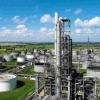|
|
Water /steam Mixture
#1

Posted 16 September 2009 - 07:05 PM
Illustration:
I have a well- insulated storage tank of 60m3 which contains 200L(.2m3) of liquid water at 75C.
The rest of the tank contains steam in equilibrium with the water.( I've calculated the initial mass of liquid water using specific volume of liquid water at 75C from a steam table)
Process steam at 2 bar and 90% quality (from an external source) enters the storage tank until the pressure
in the tank reaches 2 bar. Heat losses from the system are negligible.
(I don't quite know how to use the pressure and quality info.)
I've used it to look up the themodynamic properties of the process steam at 2 bar pressure. I'm not sure if I can justify that in principle.
I need to calculate the total amount of steam that enters the tank during the filling process.
Question #1
Given the process steam information of 2 bar and 90% quality, can I now go to the pressure steam table and get the other thermodynamic properties to completely describe the process steam. I'm talking properties such as T, specific internal energy, specific enthaply and the like.
Question #2
This illustration arises from a discussion on the conservation of mass and the first law conservation of energy.
I've not been able to get the correct solution by setting up either a vapor phase or liquid phase mass and energy balance on the tank. I reasoned that the amount of steam that enters the tank can be gotten by doing an energy balance on the vapor phase using properties from the pressure steam table.
Is this the right approach? How should I approach this?
#2

Posted 17 September 2009 - 04:34 AM
At 75 deg C the pressure is 38.5 kPaa. You know the volume (and therefore the mass) of liquid. The volume of gas is 60-0.2=59.8 m3. You can calculate its mass. I get liquid mass = 195 kg, vapour = 14.5 kg, total = 209.5 kg. Please check this before you use it.
First consider the energy balance (conservation of energy)
The total enthalpy before adding more steam is (195 * 313.8) + (14.5 * 2634) = 99384 kJ - again, please check.
The mass of 2 bar steam added is the first unknown. Let it be X kg. The vapour added is therefore 0.9X and the liquid is 0.1X. You can look up the enthalpy of vapour and liquid at 2 bar - call them HV and HL - so the total enthalpy after adding the 2 bar steam is
99384 + (0.9 * X * HV) + (0.1 * X * HL) (call this Equation A)
The second unknown is the vapour/liquid split after the 2 bar steam is added. Call this quality Y. This is the fraction between 0 and 1 of the total mass that is vapour.
The total mass after adding 2 bar steam is (209.5 + X) kg. The mass of vapour is (209.5 + X)*Y and the mass of liquid is (209.5 + X) * (1 - Y). By multiplying the masses by HV and HL respectively and adding them together you can get a second expression for the total enthalpy, which must be the same as the quantity expressed in equation A.
So now you have one expression relating X and Y.
Now we look at conservation of mass
As before, we know the total mass of liquid after adding 2 bar steam is (209.5 + X) * (1 - Y). You can divide this by its density to get its volume. Do the same for the vapour to get its volume. Adding the two volumes must give you 60 m3.
Now you have two expressions in X and Y and you can solve your problem.
#3

Posted 17 September 2009 - 09:14 AM
Answer #1Hello. I've tried to solve this problem but I don't know where I'm going wrong.
Illustration:
I have a well- insulated storage tank of 60m3 which contains 200L(.2m3) of liquid water at 75C.
The rest of the tank contains steam in equilibrium with the water.( I've calculated the initial mass of liquid water using specific volume of liquid water at 75C from a steam table)
Process steam at 2 bar and 90% quality (from an external source) enters the storage tank until the pressure
in the tank reaches 2 bar. Heat losses from the system are negligible.
(I don't quite know how to use the pressure and quality info.)
I've used it to look up the themodynamic properties of the process steam at 2 bar pressure. I'm not sure if I can justify that in principle.
I need to calculate the total amount of steam that enters the tank during the filling process.
Question #1
Given the process steam information of 2 bar and 90% quality, can I now go to the pressure steam table and get the other thermodynamic properties to completely describe the process steam. I'm talking properties such as T, specific internal energy, specific enthaply and the like.
Question #2
This illustration arises from a discussion on the conservation of mass and the first law conservation of energy.
I've not been able to get the correct solution by setting up either a vapor phase or liquid phase mass and energy balance on the tank. I reasoned that the amount of steam that enters the tank can be gotten by doing an energy balance on the vapor phase using properties from the pressure steam table.
Is this the right approach? How should I approach this?
You will be able to find the property information for wet steam from steam chart and if you prefer steam table, you have to some calculation based on saturated steam and boiling water ratio.
Answer #2
It is impossible for the tank to reach 2 bar. Because you only have 2 bar wet steam, the temperature of any mixture with 75C steam/water will be lower than 2 bar steam saturation temperature. Therefore, the tank pressure will be always lower the 2 bar.
This is not an energy conservation question. It is a concept question.
#4

Posted 17 September 2009 - 11:42 AM
You definitely can heat and pressurise the vessel and its contents to 2 barg.Answer #2
It is impossible for the tank to reach 2 bar. Because you only have 2 bar wet steam, the temperature of any mixture with 75C steam/water will be lower than 2 bar steam saturation temperature. Therefore, the tank pressure will be always lower the 2 bar.
This is not an energy conservation question. It is a concept question.
Water @ 75 deg C has an enthalpy of 313.8 kJ/kg
Water @ 2 barg (133.6 deg C) has an enthalpy of 561.3 kJ/kg
This means you must add 247.5 kJ/kg to heat the 75 deg C water to 133.6 deg C. You don't need to vapourise any of the 75 deg C water.
If there is 195 kg of 75 deg C water in the vessel to start with you need to add 48263 kJ
The latent heat of steam at 2 barg is 2162.3 kJ/kg
i.e. you must condense (48263/2162.3=) 22.3 kg of 2 barg steam
You should also correct for the steam required to pressurise the vapour space.
In a real life engineering situation this is probably the "close enough" calculation I would use rather that the full blown procedure I described earlier. To be rigorous you need to include the effect of the 2 barg water that comes in with the steam, and the need to heat the 75 deg C vapour to 133.6 deg C, and the changes in volume of water and steam as steam condenses and as the temperatures change. But these are minor effects. All of these effects are taken into account with the heat and mass balance procedure. The rigorous way is the right way for a student to do it and to understand the principles, but it would be hard to justify all that effort in the plant. One other thing that I would take into account in a real problem would be to include the effect of heating the steel shell from 75 deg C to 133.6 deg C.
#5

Posted 22 September 2009 - 11:31 AM
Thank you
Similar Topics
Steam Carrying Liquid From The Sour Water Stripping TowerStarted by Guest_kaidlut_* , 12 Sep 2024 |
|

|
||
Steam Sparger In Atmospheric Water TankStarted by Guest_owe_* , 16 May 2025 |
|

|
||
Steam Pressure In Heat ExchangerStarted by Guest_mvanrijnbach_* , 15 Apr 2025 |
|

|
||
Water Hammer Study: Hysys Dynamics Vs PipenetStarted by Guest_powerox29_* , 07 Apr 2025 |
|

|
||
Heat Exchanger Steam FlowStarted by Guest_aliebrahem17_* , 25 Nov 2024 |
|

|

 FB
FB







